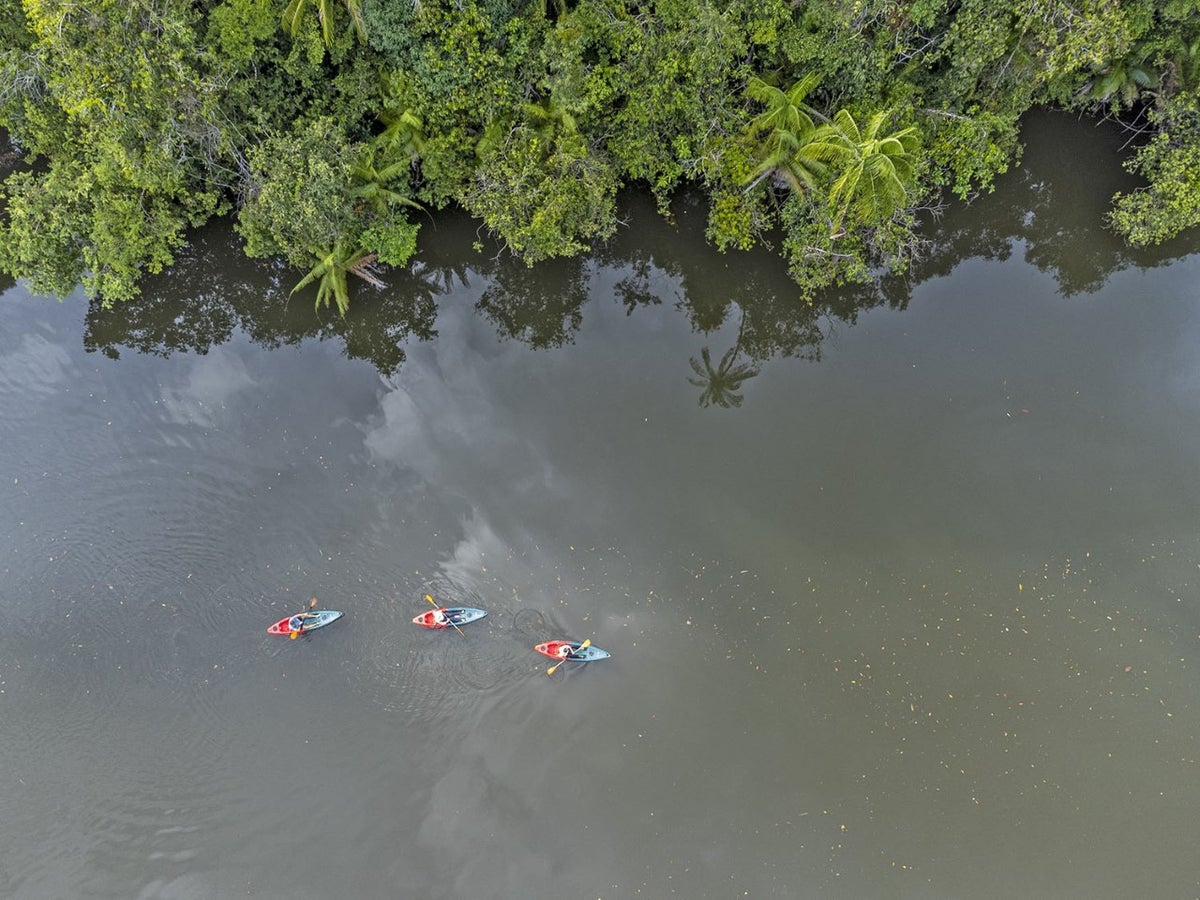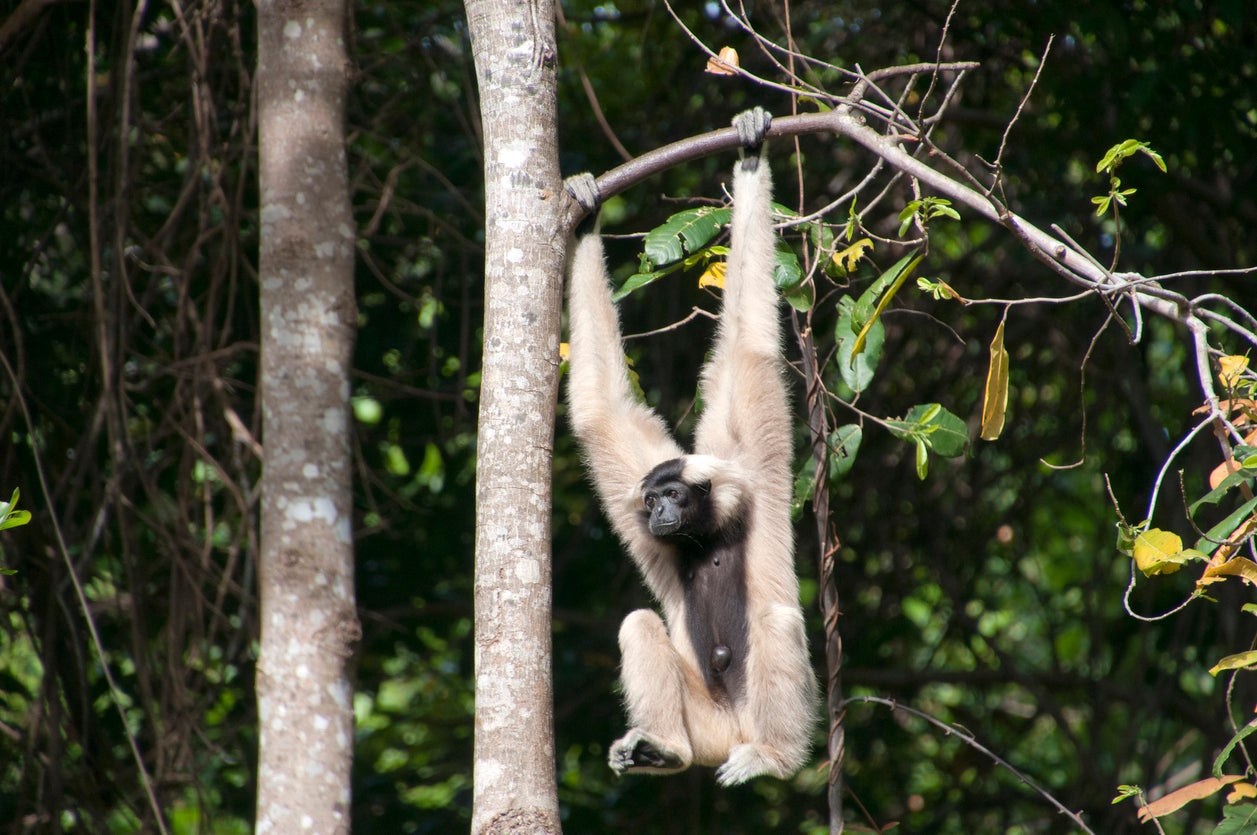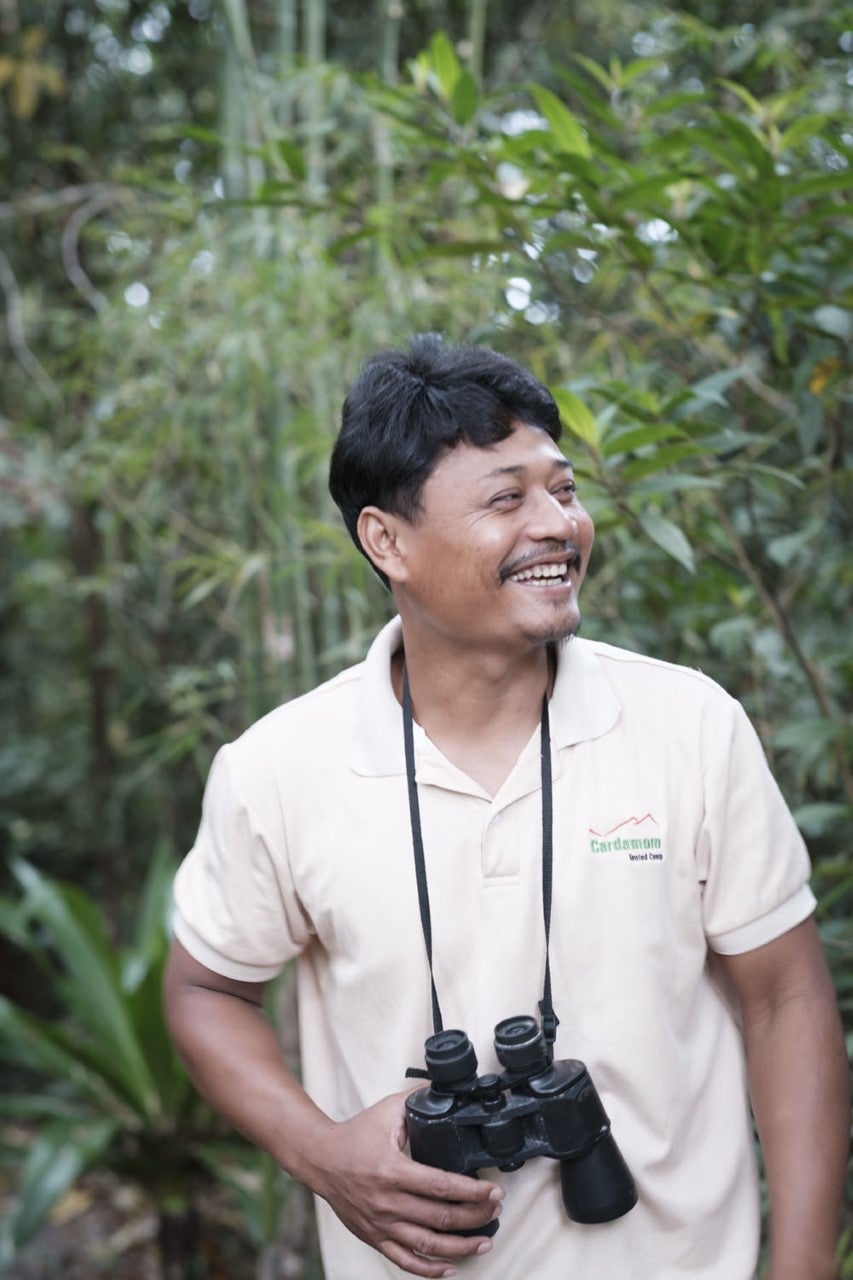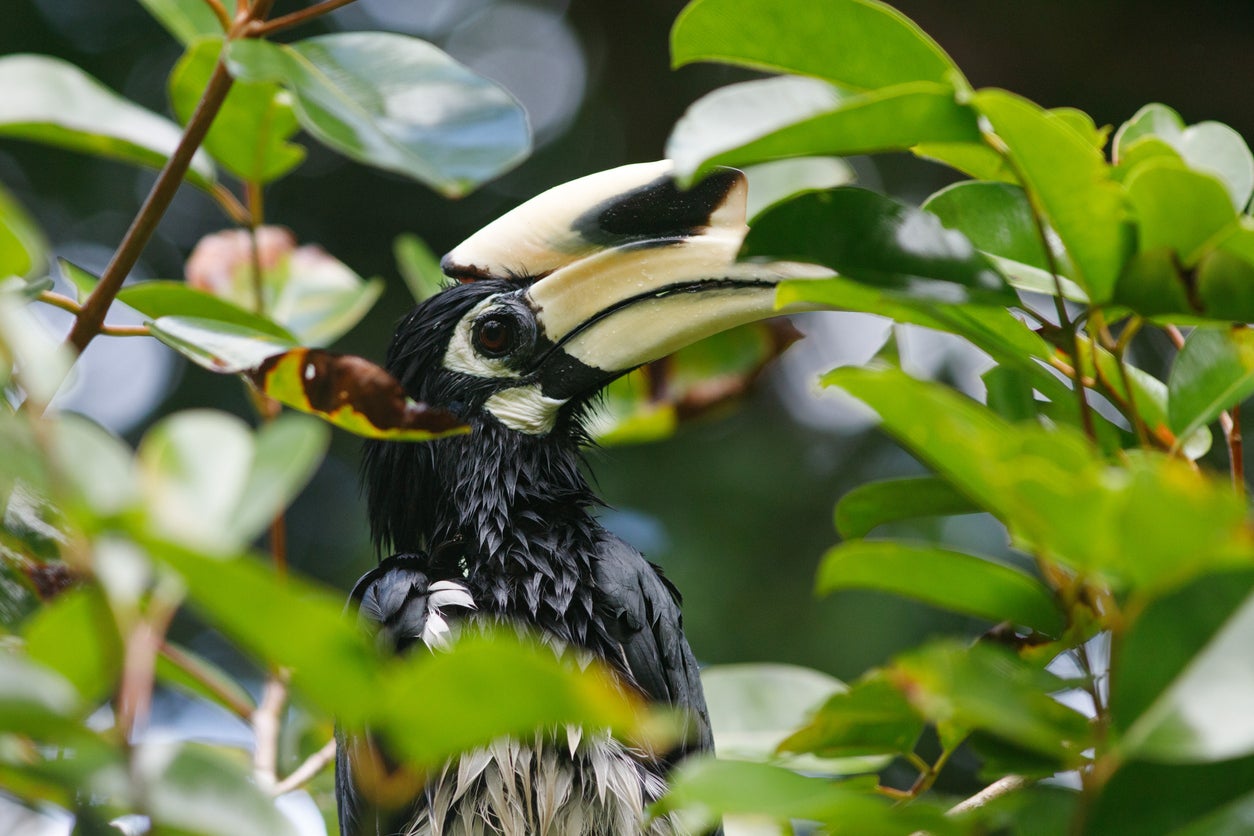
I woke with a start, the sweat cold on my forehead, without knowing why. The close air of the stormy evening had condensed into still, cool night. The forest hissed, whirred, chirruped with frogs and insects.
Somewhere far off the eerie bell-tone of an owlet rang. I could picture the bird high on a dripping branch – yellow eyes, fluffed-up feathers. The patterns of calls lulled me back into sleep. It had been a bad dream that woke me; nothing more.
Then a noise broke the night as sharply as lightning across the sky. A scream? No: a low, plaintive howl like a dog’s rising slowly into caterwaul, then falling in a bubbling rush of yaps and whoops.
It was unmistakable. Gibbons!
I grabbed my torch, stumbled out of the bed, and sent a beam into the treeline by the river. The air was velvety. Moths fluttered. Nothing.
Then suddenly I saw movement; a glint of eyeshine. It was gibbons! Wild gibbons, right outside my tent.
Finally, I’d found them. I wanted to ring home, to tell everybody. But here in Cambodia’s Cardamom Mountains there was no signal, no wifi, no contact. The only option was to savour the moment and file it away in my mind.

The Cardamoms sit in the heart of one of the last great stretches of coastal rainforest in Southeast Asia: a corrugated landscape of steamy green swamps, steep rainforest-rich ridges and caramel-brown rivers. It’s the landscape you fly over on your way from Bangkok to Angkor; or roll past on the country’s new highway between Phnom Penh and the talc-white beaches of Cambodia’s tropical islands. It’s a place even backpackers miss.
The mountains’ perfumed name had seduced me years ago, when I stumbled across it on Google Maps. I imagined scented hills and fragrant trees. Then a search revealed something more interesting: orchid and bromeliad-dripping forests filled with wild elephants, clouded leopards, pangolins, critically endangered Siamese crocodiles… and gibbons. I’d always wanted to see these most elusive of apes, those high-tree swingers that spend their lives in the canopy of great, untroubled forests.
I hadn’t had a chance to visit this paradise before the pandemic. I waited patiently. Then, as Covid diminished, good news from Cambodia – as well as a reopening to tourists, the country announced a string of sustainability initiatives that echoed ideas from Costa Rica, a Central American beacon of conservation and responsible tourism.
These included a World-Bank-funded Sustainable Landscape and Ecotourism Project, set to run until 2025; an anti-poaching initiative in wild Mondulkiri Province; and a plan to introduce Indian tigers into the wild forests of the Cardamom mountains (they’ve been extinct here since 2007). According to the International Union for Conservation of Nature (IUCN), tiger numbers had increased 40 per cent worldwide between 2015 and 2022, thanks to similar conservation initiatives in India and Nepal. Could Cambodia’s green future become part of that success story, too?
I booked a flight as soon as I could; I planned to work my way down to a tented riverside camp in the Cardamom Mountains via some ethical tours, local encounters and, ideally, gibbons.

My first stop, inevitably, was Angkor, where I strolled the majestic Angkor Wat and Bayon sites with wildlife guide Buntha Chheang. We walked through towering forest and the mossy ruins of magnificent 12th-century buildings. Buttery light glinted off King Suryavarman’s vast lotus-flower filled moat at the edge of Angkor Wat.
Life was everywhere – terrapins in the water, butterflies floating like drifting petals, swallows flitting around the ancient wall. Buntha pointed out rare birds: an electric-blue Hainan Flycatcher, an Oriental Darter, a Black Crested Bulbul.
“The pandemic was good for the forest,” he told me. “Hornbills came back in numbers. You could see them in hotel gardens in Siem Reap city.
“Gibbons were released; they are breeding now. Otters, too. There is even talk that clouded leopards will return. It’s good news for the plants and animals.”
It was this blooming of local fauna, he said, that had woken the authorities to Angkor’s natural treasures as well as the historical ones, spurring them to think harder about the true value of the forest. They looked to Costa Rica, and the Mayan ruins between Cancún and Guatemala. Perhaps Angkor could be enhanced by a more concerted effort to protect the ecosystem around it.

“But they will lose out”, said Buntha, pointing to a group of sellers hawking T-shirts and bottled water. True ecotourism, he explained, must include the welfare of local people as partners. It’s a sentiment enshrined in the UN World Tourism Organisation’s definition of sustainable tourism as “providing alternative employment and income opportunities” and “using small, locally owned businesses” as suppliers.
Inspired back in Siem Reap town, I went in search of tourism that was more than just “green”, but also community-orientated.
I’d already chosen my hotel carefully with this in mind. My temporary home, Jaya House, was beautiful – high glass walls and huge, softly lit honey and whitewash bedrooms, set in lush riverside gardens. But it was also plastic free, used locally sourced products and exclusively employed people from around Siem Reap – many of them from rural backgrounds who usually struggled to find work in the town’s plush tourism sector.
I also visited Apopo, where rodents as big as cats are trained to sniff out munitions and mines, dropped by American planes and planted by the Khmer Rouge and the Vietnamese. These still litter Cambodia’s countryside.
I took a food tour with Urban Forage – a degustation dip into locally owned and run Khmer restaurants such as Banllé, Mahob, Pou and Wild, all opened by alumni of the big-name resorts. All resolutely Khmer. The cooking was refined and gourmet, a re-invention of rice-field and farmhouse food as fine dining.
Even teeming Phnom Penh – my second stop in the country – had a sustainable tourism scene to dig into. My hotel, the view-blessed Rosewood Phnom Penh, recommended MOTO GIRL tours: a female-led business and one of a string of small local ventures set up by young Cambodians. These entrepreneurs have high hopes that tourists will support their efforts.

My MOTO GIRL guide, Manich, scootered me elegantly past temples, new glass towers and through the whirl of traffic, before taking me to eat fresh spring rolls at street stalls. She showed me dance and vivid, rococo street art, and in the shadow of the Royal Palace we watched locals conduct a rapid-fire rap battle over percussive Khmer hip hop.
The Cardamom Mountains were my final stop – the country’s greatest wilderness, the potential jewel in its ecotourism crown. On the morning after the night of gibbon calls, I was kayaking down the lazy, jungle-lined, turtle-filled river that runs right through the Cardamom Tented Camp. Sina, one of its gregarious guides, told me how important the camp’s mission was to the future of the Cardamoms.
The Tented Camp exists in a buffer zone created in 2021, ostensibly to redistribute land to locals on a small, sustainable scale. But many of the concessions were suspiciously close to property owned by powerful magnates. Fearing a land grab, the camp’s owners purchased 18,000 hectares of land abutting Botum Sakor National Park, around the beautiful Prek Tachan River.
“The Cardamoms are a last refuge for animals and plants that have largely disappeared from mainland Southeast Asia,” he told me. “They’re still home to rare Siamese crocodiles, hairy nosed otters and Malayan sunbirds. Our rivers are home to the largest population of critically endangered royal turtles in the region.
“Under the new rewilding programme we will get our tigers back, too. Forest elephants will be protected, and of course our gibbons will thrive.”
And as if on cue, we heard their call once again: a huddled family high in the branches, with fur as white as an old man’s beard. They peered down, beady-eyed and grinning.
“They’re happy to see you,” joked Sina, “They want you to tell everyone to visit the Cardamoms, to come to Cambodia.”
I heard their call. Cambodia needs visitors. If the country has a green future, it will be through a patchwork of government schemes, private eco-lodges like the Tented Camp built by determined investors, and small, locally owned ventures.
It was the success of jungle lodges in Sarapiqui and the Costa Rican Cordillera that prompted former president Oscar Arias Sanchez to go beyond PR and create Costa Rica’s first properly protected national parks. And just as in 1980s Costa Rica, if Cambodia is to go beyond a tentative beginning, it is carefully spent tourist money that will make all the difference.
Travel essentials
Alex Robinson travelled withThe Earth Trip, who offer sustainable holidays in Cambodia combining Siem Reap, the Cardamoms and Phnom Penh from £3,327pp, including return international flights, hotels, transfers and excursions. Enquiries: info@theearthtrip.com; 07871 169 558.







